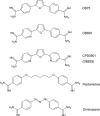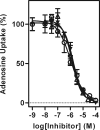Trypanocidal furamidine analogues: influence of pyridine nitrogens on trypanocidal activity, transport kinetics, and resistance patterns
- PMID: 21402852
- PMCID: PMC3088251
- DOI: 10.1128/AAC.01551-10
Trypanocidal furamidine analogues: influence of pyridine nitrogens on trypanocidal activity, transport kinetics, and resistance patterns
Abstract
Current therapies for human African trypanosomiasis (HAT) are unsatisfactory and under threat from emerging drug resistance linked to the loss of transporters, e.g., the P2 aminopurine transporter (TbAT1). Here we compare the uptake and trypanocidal properties of furamidine (DB75), recently evaluated in clinical trials against stage 1 (haemolymphatic) HAT, and two aza analogues, DB820 and CPD0801 (DB829), which are candidate compounds for treatment of stage 2 (neurological) disease. Values of 50% inhibitory concentrations (IC50s) determined in vitro against both wild-type and transporter mutant parasites were submicromolar, with DB75 trypanotoxicity shown to be better than and DB820 trypanotoxicity similar to that of the widely used veterinary trypanocide diminazene, while CPD0801 was less active. Activity correlated with uptake and with the minimum drug exposure time necessary to kill trypanosomes: DB75 accumulated at double and 10-fold the rates of DB820 and CPD0801, respectively. All three compounds inhibited P2-mediated adenosine transport with similar Ki values, indicating affinity values for this permease in the low to submicromolar range. Uptake of DB75, DB820, and CPD0801 was significantly reduced in tbat1-/- parasites and was sensitive to inhibition by adenine, showing that all three compounds are substrates for the P2 transporter. Uptake in vitro was significantly less than that seen with parasites freshly isolated from infected rats, correlating with a downregulation of P2 activity in vitro. We conclude that DB75, DB820, and CPD0801 are actively accumulated by Trypanosoma brucei brucei, with P2 as the main transport route. The aza analogues of DB75 accumulate more slowly than furamidine itself and reveal less trypanocidal activity in standard in vitro drug sensitivity assays.
Figures








Similar articles
-
Accumulation and intracellular distribution of antitrypanosomal diamidine compounds DB75 and DB820 in African trypanosomes.Antimicrob Agents Chemother. 2006 Jun;50(6):2185-91. doi: 10.1128/AAC.00192-06. Antimicrob Agents Chemother. 2006. PMID: 16723581 Free PMC article.
-
Roles for the Trypanosoma brucei P2 transporter in DB75 uptake and resistance.Mol Pharmacol. 2006 Nov;70(5):1585-92. doi: 10.1124/mol.106.024653. Epub 2006 Aug 15. Mol Pharmacol. 2006. PMID: 16912218
-
New treatment option for second-stage African sleeping sickness: in vitro and in vivo efficacy of aza analogs of DB289.Antimicrob Agents Chemother. 2009 Oct;53(10):4185-92. doi: 10.1128/AAC.00225-09. Epub 2009 Jul 20. Antimicrob Agents Chemother. 2009. PMID: 19620327 Free PMC article.
-
Drug transport and drug resistance in African trypanosomes.Drug Resist Updat. 2003 Oct;6(5):281-90. doi: 10.1016/j.drup.2003.09.001. Drug Resist Updat. 2003. PMID: 14643298 Review.
-
Diamidines for human African trypanosomiasis.Curr Opin Investig Drugs. 2010 Aug;11(8):876-83. Curr Opin Investig Drugs. 2010. PMID: 20721830 Review.
Cited by
-
Crystal structure of an arginase-like protein from Trypanosoma brucei that evolved without a binuclear manganese cluster.Biochemistry. 2015 Jan 20;54(2):458-71. doi: 10.1021/bi501366a. Epub 2014 Dec 23. Biochemistry. 2015. PMID: 25536859 Free PMC article.
-
Efficacy of two novel 2,2'-bifurans to inhibit methicillin-resistant Staphylococcus aureus infection in male mice in comparison to vancomycin.Drug Des Devel Ther. 2012;6:279-87. doi: 10.2147/DDDT.S36437. Epub 2012 Oct 12. Drug Des Devel Ther. 2012. PMID: 23091372 Free PMC article.
-
Targeting Channels and Transporters in Protozoan Parasite Infections.Front Chem. 2018 Mar 27;6:88. doi: 10.3389/fchem.2018.00088. eCollection 2018. Front Chem. 2018. PMID: 29637069 Free PMC article. Review.
-
In vitro and in vivo evaluation of 28DAP010, a novel diamidine for treatment of second-stage African sleeping sickness.Antimicrob Agents Chemother. 2014 Aug;58(8):4452-63. doi: 10.1128/AAC.02309-13. Epub 2014 May 27. Antimicrob Agents Chemother. 2014. PMID: 24867978 Free PMC article.
-
Arylimidamides Have Potential for Chemoprophylaxis against Blood-Transmitted Chagas Disease.Pathogens. 2023 May 12;12(5):701. doi: 10.3390/pathogens12050701. Pathogens. 2023. PMID: 37242371 Free PMC article.
References
-
- Al-Salabi M. I., et al. 2007. Molecular interactions underlying the unusually high affinity of a novel Trypanosoma brucei nucleoside transporter. Mol. Pharmacol. 71:921–929 - PubMed
-
- Balasegaram M., et al. 2009. Effectiveness of melarsoprol and eflornithine as first-line regimens for gambiense sleeping sickness in nine Médecins Sans Frontières programmes. Trans. R. Soc. Trop. Med. Hyg. 103:280–290 - PubMed
-
- Barrett M. P., Zhang Z. Q., Denise H., Giroud C., Baltz T. 1995. A diamidine-resistant Trypanosoma equiperdum clone contains a P2 purine transporter with reduced substrate affinity. Mol. Biochem. Parasitol. 73:223–229 - PubMed
-
- Barrett M. P., Fairlamb A. H. 1999. The biochemical basis of arsenical-diamidine crossresistance in African trypanosomes. Parasitol. Today 15:136–140 - PubMed
-
- Barrett M. P., et al. 2003. The trypanosomiases. Lancet 362:1469–1480 - PubMed
Publication types
MeSH terms
Substances
LinkOut - more resources
Full Text Sources

